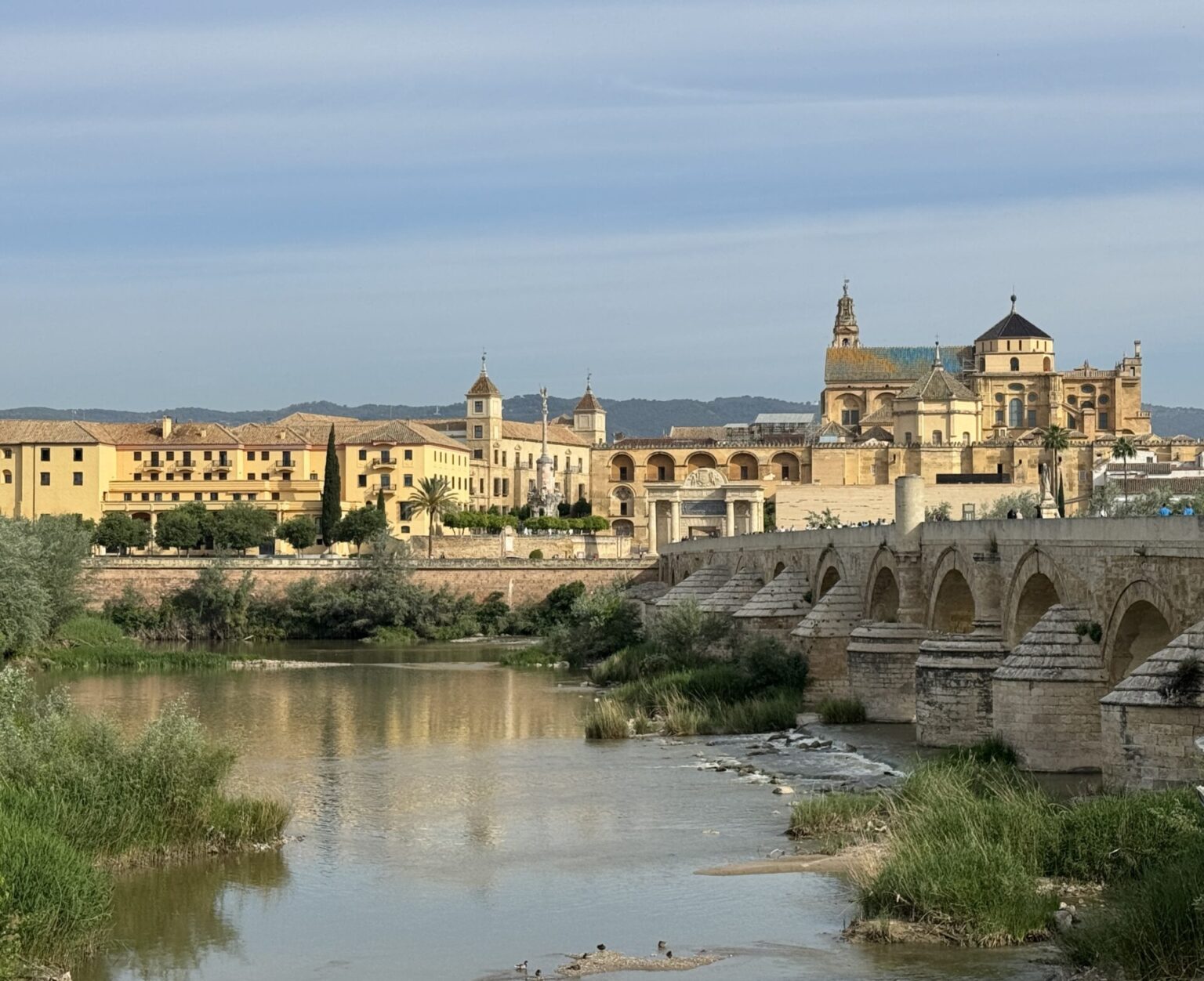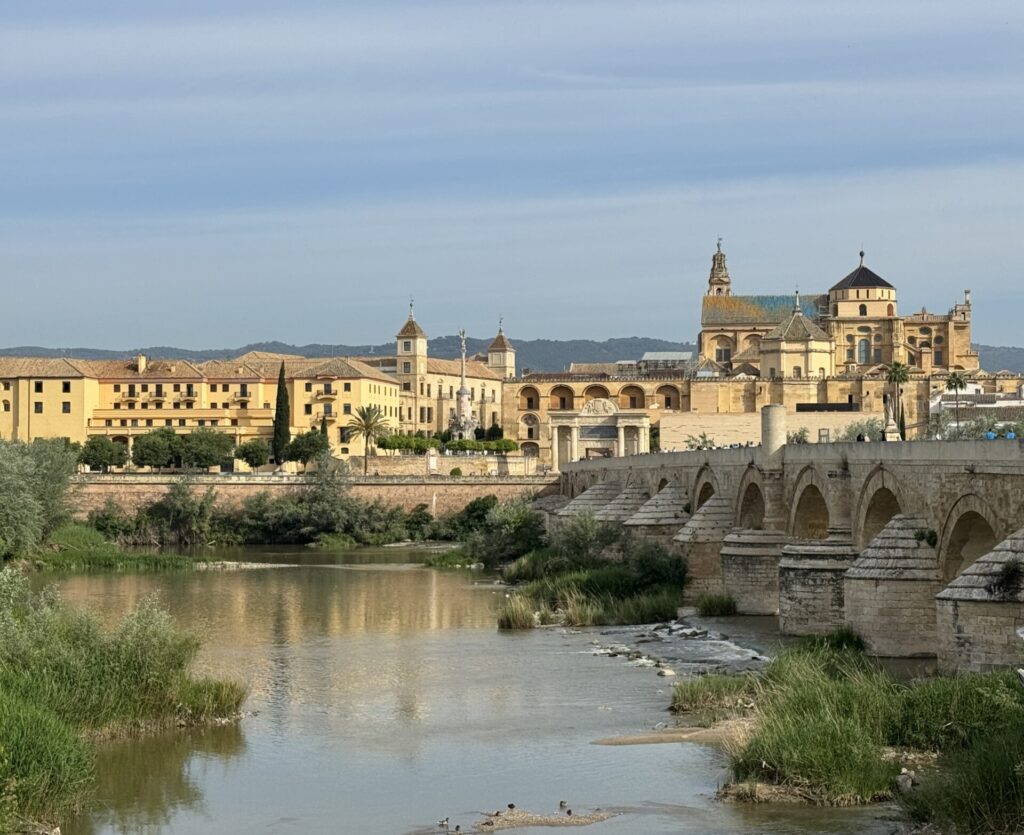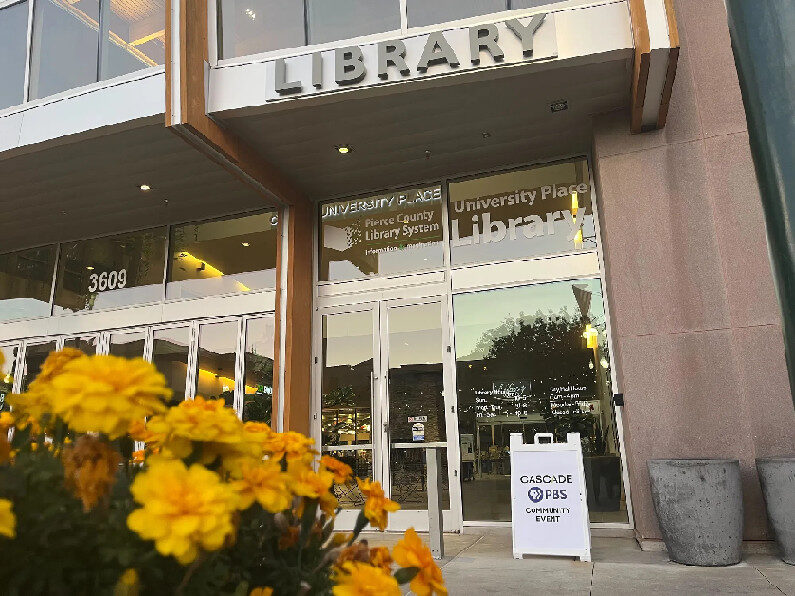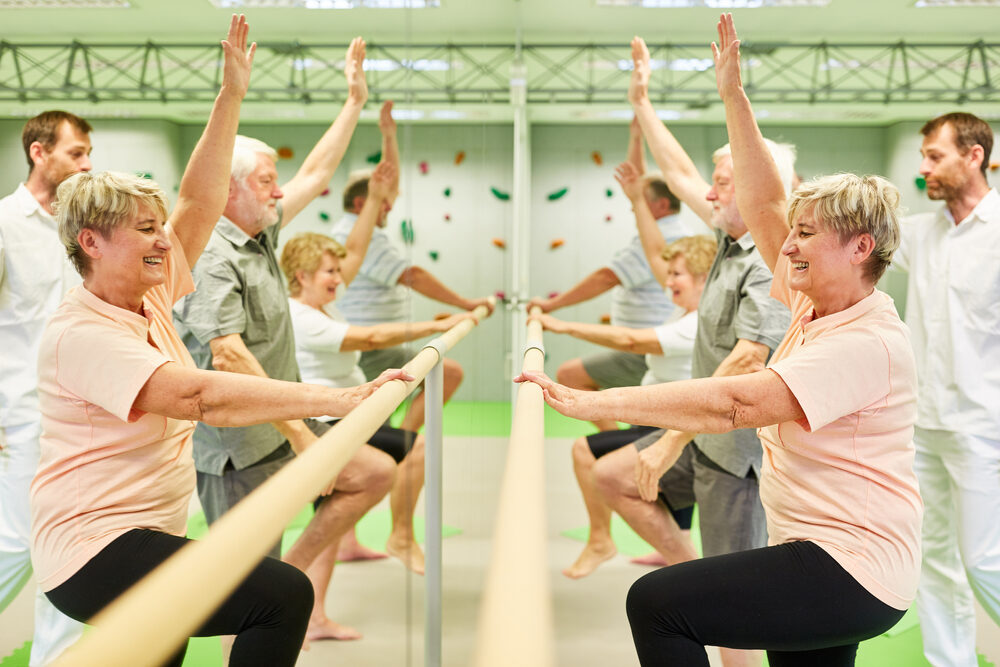You’ll probably get lost while wandering around the pretty whitewashed streets of Córdoba’s historic old town, but don’t panic. It’s part of the allure of one of Spain’s most charming towns.
Located among rolling hills on the banks of the Guadalquivir River, Córdoba lies in the heart of the Andalucian plains. It can get hot here, very hot, which is why you won’t see many locals out and about during the midday hours. They’re wisely inside, though the inevitable tourists can be found roaming the nearly deserted streets, often with a dazed expression. This could be the result of the blazing heat or because they’ve gotten turned around in the rabbit warren of pathways. Or it could be because they’re in awe of this enchanting place. Speaking from experience, it’s most likely a mix of all of the above.
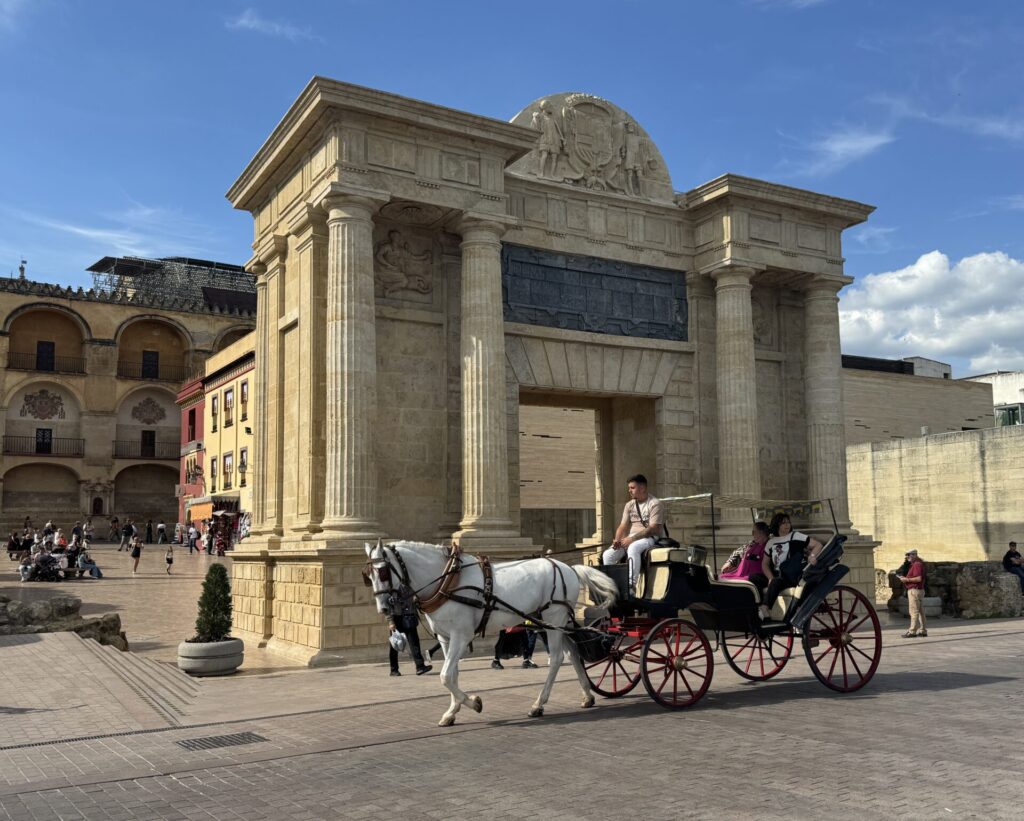
Córdoba has the distinction of being one of the best-preserved old towns in Europe. It’s a UNESCO World Heritage site in its entirety with significant Roman roots. Many of the influential Roman elite retired here and they developed Córdoba as capital of its region. Today, you’ll see physical reminders of the Romans’ footprint in the town, from the Córdoba Roman Bridge over the Guadalquivir River and its defensive tower to a number of notable mosaics and gardens created in the Roman style.
After the Roman empire collapsed, it was the Moors who really put Córdoba on the map, eventually making it the largest and most prosperous city in the world. The Moors created a center of learning by gathering the knowledge of prior civilizations together, as opposed to purging all the brain power from these societies. It’s also important to mention that during this time, Christian, Islamic and Jewish cultures coexisted peacefully.
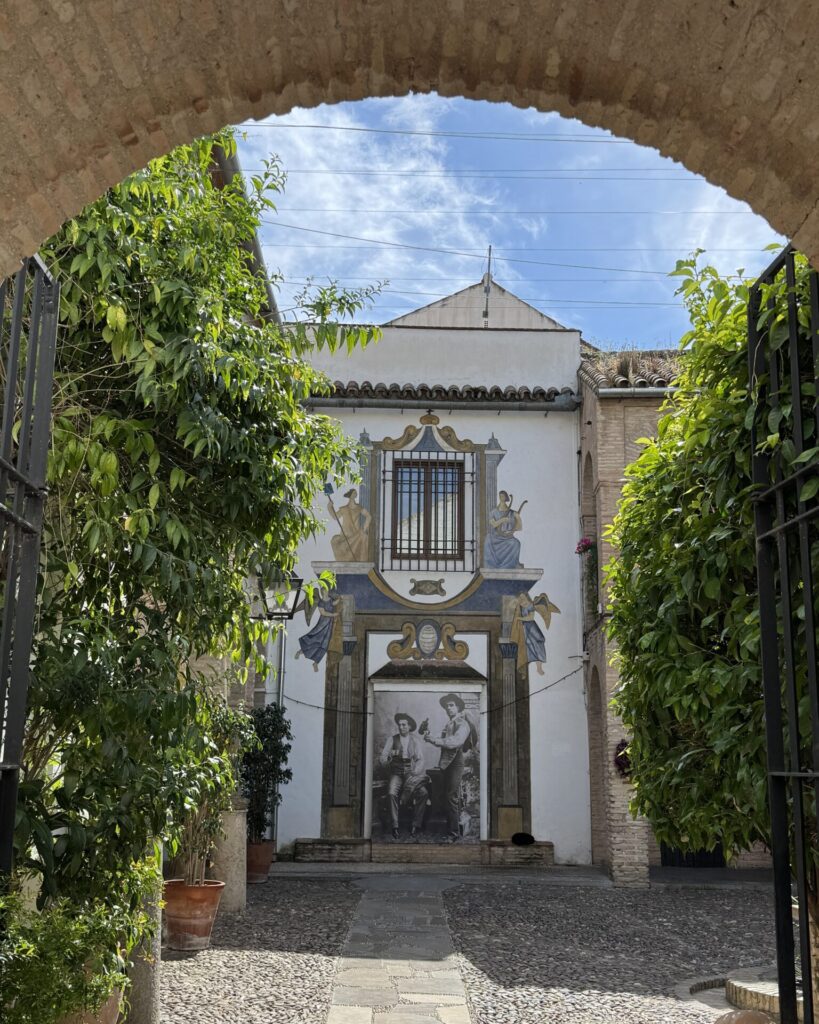
However, this all changed in the 13th century when Córdoba was conquered by the Christians and its days as a political and cultural capital came to an end. Churches and convents were planted throughout the city to erase its Islamic past and the Moors who did not convert to Christianity were persecuted and expelled.
Like the Romans, the Moors also left their mark on the town. The Mosque-Cathedral of Córdoba, or the Mezquita as it is commonly called, is Córdoba’s most iconic landmark. And for good reason, as it’s regarded as one of the world’s most impressive works of Islamic architecture. It also has the distinction of being the only mosque-cathedral in the world.

The mosque, which dates back to AD 784, went through several expansions over the years, as different caliphs added new wings and enhancements. The result is a mixture of architectural styles superimposed on one another.
Much later, in the 16th century, Spain’s King Carlos I ordered a Christian cathedral to be built right in the middle of the mosque, along with several dozen chapels around the peripheries. In doing so, the central part of the mosque was destroyed.
When you approach the building, take time to enjoy the lovely courtyard with its fountains, and stroll around the orange grove, which is free and open to the public.
An archway forms the entrance to the Mezquita and is where the ticket office is situated. Nearby is the bell tower with the minaret encased in it. You can climb to the top of the tower for a superb panorama.
Once you step inside this grand building, you’ll be in the immense prayer hall. Size wise, it’s a whopping 155,000 square feet! Now picture the sight of 20,000 people praying, side by side.
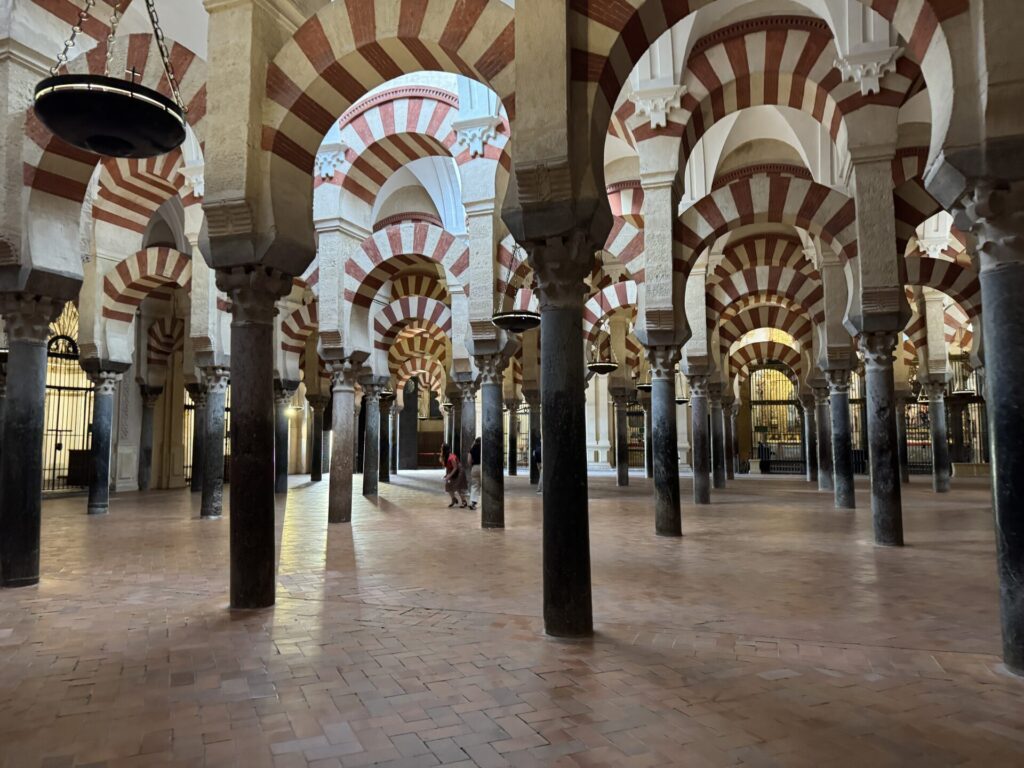
You’ll walk through what seems like an endless series of striped red brick and white stone arches that are laid out in a repeated geometrical format. I was told these arches are suggestive of a forest of date palms.
The arches rest on columns, 856 to be exact, and made of marble, granite and jasper. They are different sized, as they came from recycled material collected at various Roman sites. And to get the ceiling high enough to give the place a sense of openness, the Moors came up with the ingenious idea to create a double-tiered symmetrical construction. Taller columns served as the base for shorter ones on top.

The pivotal point in this hall is the horseshoe arched mihrab or prayer niche, which identifies the wall that faces Mecca. The arch is lavishly decorated with glittering gold mosaic cubes. Above the mihrab is a dazzling dome also elaborately decorated.
As for the cathedral, you’ll note several different styles, including Gothic, Baroque and Renaissance. The altar is marble and the pulpits are also marble with mahogany wood. And the choir is also a work of art with its rich mahogany stalls.
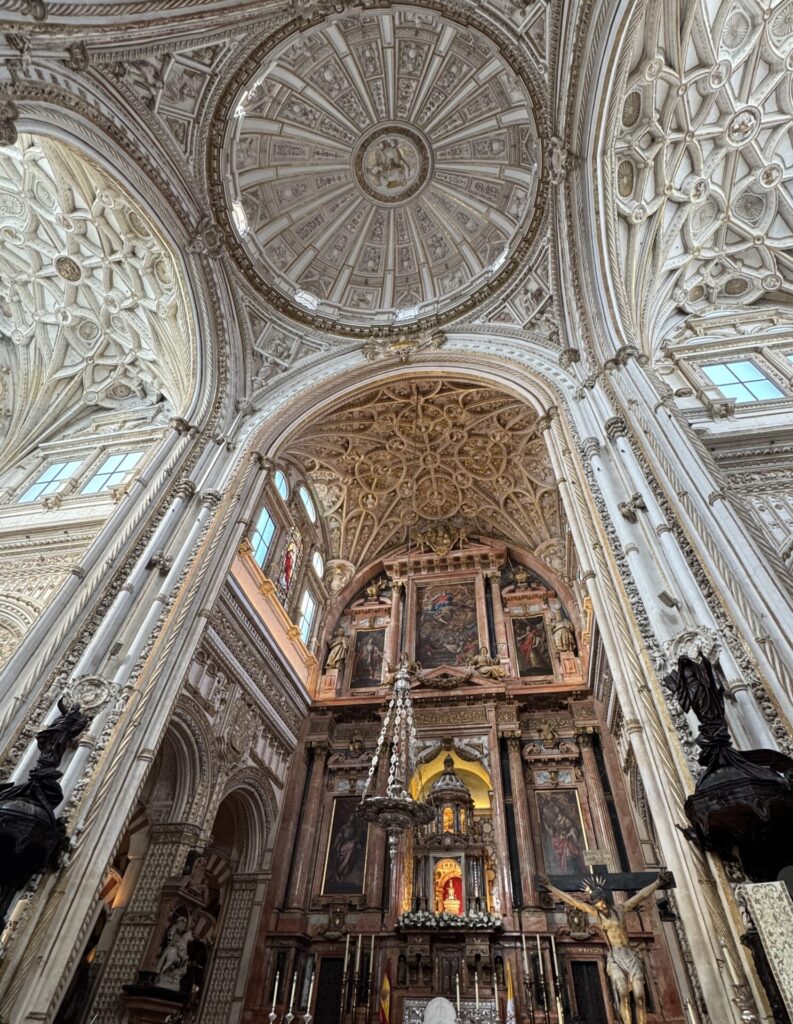
Another site that combines Roman and Arabic architectural elements is the Alcazar of the Christian Monarchs, which dates back to 1328 AD. Over the years, it served as both a fortress and a palace, and was once the headquarters of the Spanish Inquisition. The building is formidable in size and boasts stone walls, towers, Gothic style cupolas, a Baroque chapel, courtyards, grand gardens, water features and more. Also notable is the Hall of the Mosaics, where lavish Roman mosaics are displayed around the walls.
For more Roman flavor, take time to walk across the aforementioned Córdoba Roman Bridge. Built in the 1st century BC, the bridge straddles the Guadalquivir River and has sixteen arches. You might recognize this landmark, as it was featured in the famous TV series, “Game of Thrones.”
At one end of the bridge is the stalwart Calahorra Tower, which dates back to the 12th century, and was used to protect the bridge. At the other end, you’ll see the Mezquita, so whatever direction you walk in, you’ll be rewarded by great views. And nearby, on the banks of the river is a medieval water mill, originally built to carry river water up to the palace via an aqueduct.
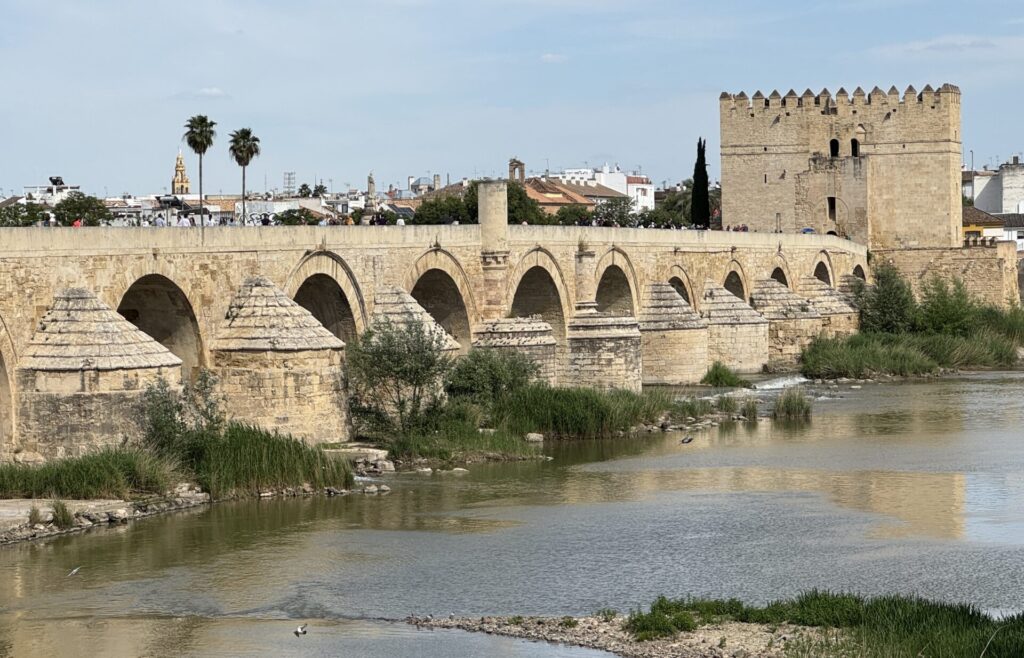
Córdoba’s Jewish Quarter is the historic center of the city. Though many Jewish people once dwelled here, today, there are very few Jews living in the town. However, their influence can be seen in the architecture, along with the sole remaining synagogue.
The synagogue, which no longer functions religiously, but is open to the public, is among the top three best preserved medieval synagogues in all of Spain. It was constructed in 1315 and was in use until the Jews were expelled from Spain. When touring the temple, you’ll go through a courtyard, which leads into an entrance hall. A staircase leads to the women’s area, as women sat separately from men. The main hall is a small, rectangular-shaped room with decorative arches and walls with plant-like motifs.
After 1492, the building served as a hospital, a hermitage and an infants’ school. It was declared a National Monument at the end of the 19th century.
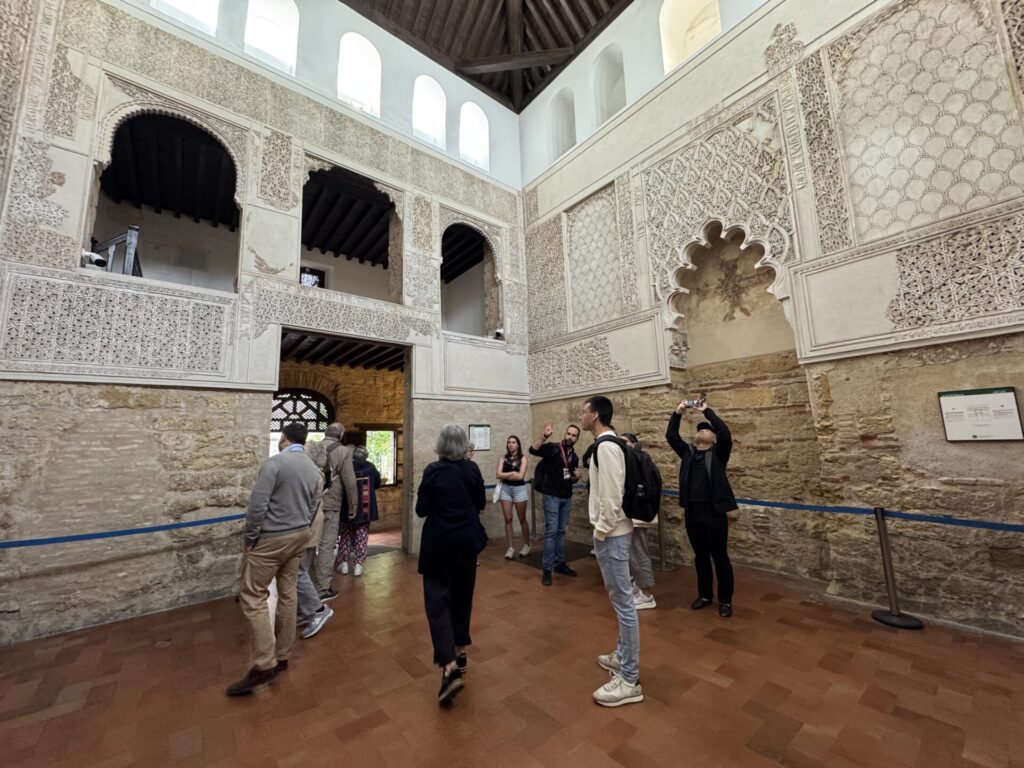
In the heart of the Jewish Quarter is Calleja de las Flores (street of the flowers), one of the city’s most famous streets. In season, it’s usually full of flowers that fill the wrought iron balconies and hang from pots on the walls. From here you can get a view of the bell-tower of the Mezquita. As you can probably imagine, this charming street is a magnet for tourists and their cameras.

If you’re an equestrian aficionado, you’ll want to stop by the Royal Stables, a UNESCO World Heritage Site, and home to the famous Andalusian horses. Felipe II founded the stables in 1570 as the place to breed the Andalusian Horse, a pure Spanish thoroughbred. Regarded as one of the greatest breeds of horse ever to exist, this thoroughbred became a very popular riding horse and a symbol of the Spanish empire. It’s known for being strong and agile, possessing an elegant presence.
Córdoba is the birthplace of this horse and visiting the Royal Stables offers visitors the opportunity to see these impressive creatures up close. You can watch them during a training session, while soaking up the ambiance of the historic building’s Renaissance architecture.
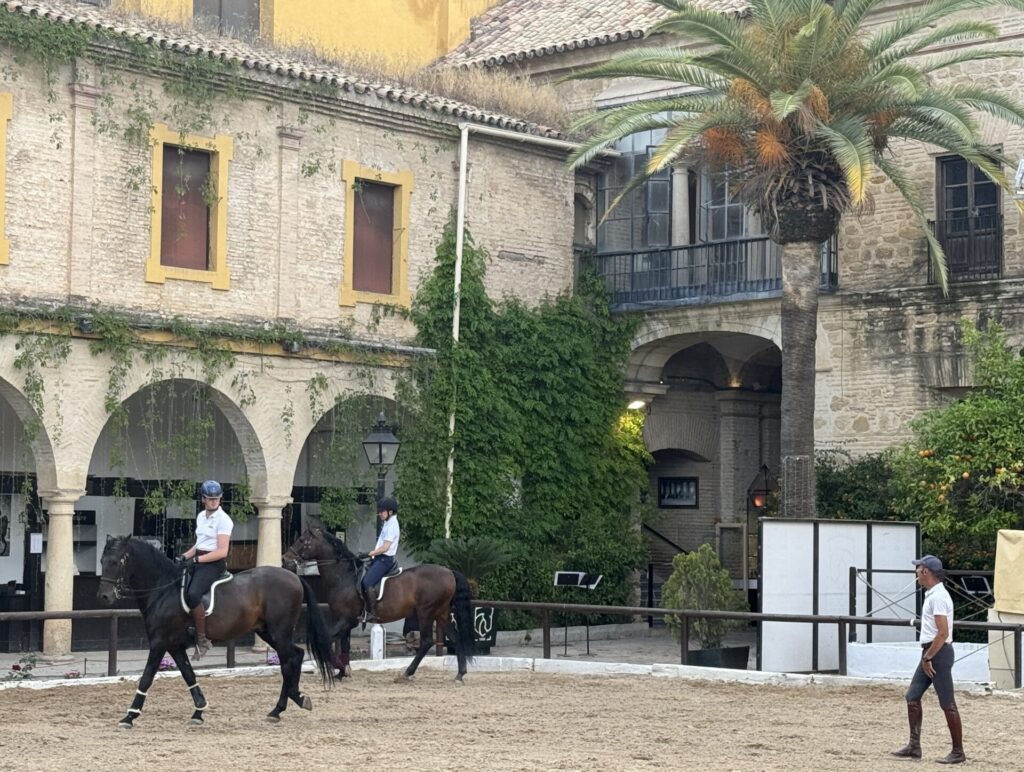
These stables are also renowned for their equestrian show, which combines traditional music, Flamenco dance and dressage. It’s an exceptional experience to witness the harmony between these stunning, graceful horses and their riders, as well as the way the Flamenco dance blends with the equestrian movements.

In many Spanish towns, festivals take centerstage at various times of the year. For Córdoba, spring is festival season. One of the city’s most beloved events is the Fiesta of the Patios, which occurs over twelve days at the beginning of May. Fortunately, my stay coincided with this time period, so I was able to experience this special festival.
This event is a tradition that began in 1918, but was interrupted by the Spanish civil war, then reintroduced in the 1950s. It’s an seminal part of the city’s cultural heritage and an expression of identity within the Cordovan community.
The patio houses are communal, family or multi-family dwellings or sets of individual homes that share a patio, and are located within the city’s historical quarter. Residents spend much time and effort each year to decorate these spaces with vibrant flowers and plants – real ones, never artificial. And there is a competition involving strict criteria with regards to floral variety, natural lighting, care of the flowerpots and beds, etc., with prize money awards in different categories.
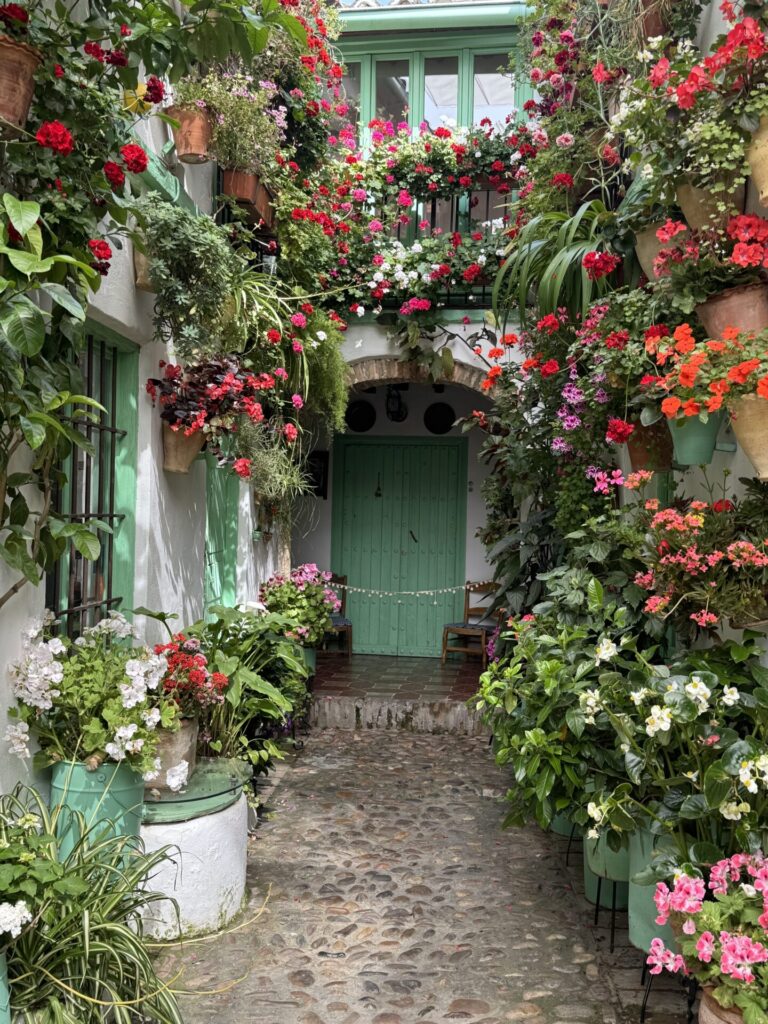
The patios are open and free to the public during the festival for visitors to admire the beauty and skill involved in these creations. Some of the patios even host traditional singing, flamenco guitar playing and dancing.
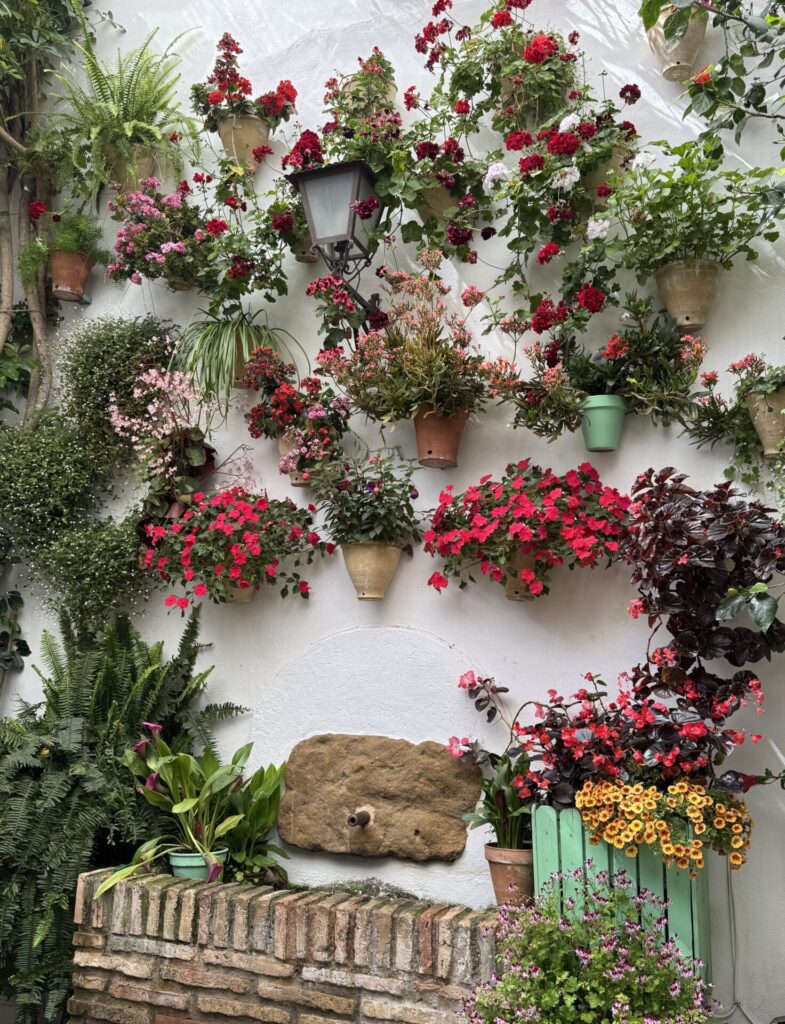
You’ll definitely encounter lines to enter the patios, but it’s well worth the wait. They are each unique and stunning in their artistry. The flowers dazzle in an array of brilliant hues and the compositions are amazingly creative. It’s a feast for the senses and a photographer’s dream.

